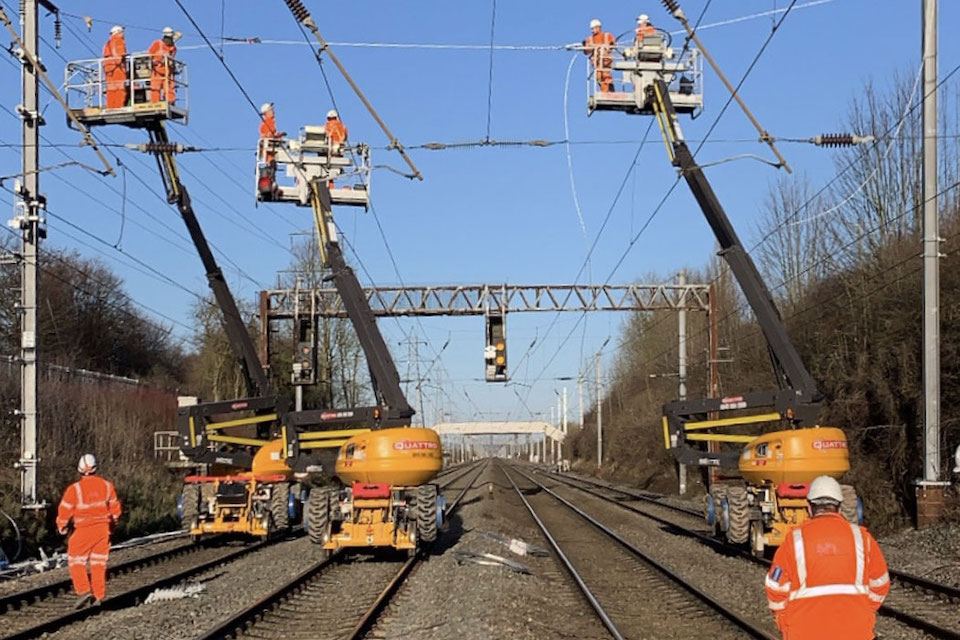A combination of outdated equipment and changing weather patterns have put several UK trunk routes at risk of disruption. Among the lines most at risk are the vital freight routes of the West Coast Main Line and the Great Western Main Line. Critical lines out of Manchester are also at risk. However, the danger highlighted by this report is not the extremes of rainfall and flooding. It’s the heat of summer that could be the biggest threat.
The British arm of railway electrification engineering specialists Furrer+Frey has published an updated report into the effects of summer weather on the railway network. The Climate Resilience in Rail Electrification report examined many aspects of the ageing installations that serve many parts of the British network. The report even highlights equipment still in daily use but installed before the Second World War.
Impacts on HS2
The Furrer+Frey team pioneered a moving catenary system designed to extend electrification into freight terminals. Now, a new paper from the British electrification engineers at Furrer+Frey has rang alarm bells for freight and passenger operators alike. The report, an update to 2023’s Climate Resilience in Rail Electrification, identifies five railway lines in need of immediate assessment and renewal to prevent further disruption and delays for operators and customers. The report also highlights the social and economic impacts of disruption to the main arteries of the GB network.

Electrification equipment, principally the overhead line equipment, is particularly susceptible to the effects of prolonged high temperatures – a weather pattern that climate scientists say the UK can expect to experience more often in the Among the five lines most at risk, says the report, is the northern section of the West Coast Main Line (between Crewe and Glasgow). The significance of this has not been lost on the railway industry. The section of the West Coast Main Line most at risk is also the section that will be expected to carry HS2 traffic now that the high-speed project has been curtailed to terminate at Birmingham.
Pre-war installations still in use
The summer 2024 update to the Furrer+Frey 2023 report Climate Resilience in Rail Electrification summarises the climate threats facing British railways. The paper also recognises the top five sections of electrified lines most at risk. The most remarkable is the vestige of a line which once connected Manchester and Sheffield – an early electrification project called the Woodhead Route.

Although the line now only exists as a mothballed section serving a steelworks in Sheffield, and a commuter route into Manchester, the original equipment is still in use, says the report. “Built from 1938 to 1954 in DC and converted to 25kV in 1984. A lot of original fixed termination equipment exists,” says Furrer+Frey. “This route is by far the most impacted, with regular speed restrictions even in mild hot weather.”
Impact on ageing equipment
Freight traffic stands a greater chance of disruption on the other four routes identified as at risk. The commuter route between Tilbury and London is described as almost as vulnerable as the vestiges of the Woodhead Route. “There are still sections of track using equipment built before the 1990s which cannot withstand our increasingly volatile weather,” said Noel Dolphin, co-author of the report and Managing Director of Furrer+Frey GB. “If we want to avoid train delays, cancellations and disruption, particularly on the hottest days of the year, we really need to look at renewing outdated equipment.”

The port operations from Tilbury, London Gateway and other locally-based industrial installations are all served by diesel-hauled trains, but they could all be affected by disruption to overhead line equipment. Similarly, there is potential for disruption or the need for diversion for freight services using the West Anglia routes, radiating out of Liverpool Street in London. “The line is already highly unreliable, and the impact of climate changes on already ageing equipment will be significant,” says the report. “The initial focus should be on fixed termination areas before renewing the remainder.”
West Coast at risk and potential solutions
The Great Western Mainline between London Paddington and Heathrow has the potential to disrupt services along the length of the line into the West of England and South Wales. However, the always busy West Coast Main Line gives the most cause for concern. Referring to the electrification equipment, the report raises an alarm over the ability of the route to cope with climate change. “Climate resilience is built into new and renewed electrification,” says the report. “They are reliable even in a changing world. The highest risk is to electrification equipment built before the 1990’s. Sections between Crewe and Glasgow have not been renewed and have increased unreliability.”
The report makes several recommendations, which address changing climate conditions. Furrer+Frey recommend a network-wide reassessment. “Base (set-up) temperatures are too low, and the existing systems’ temperature ranges need to be reviewed,” quotes the report. The electrical engineering specialists advocate an immediate assessment and renewal of vulnerable legacy assets.